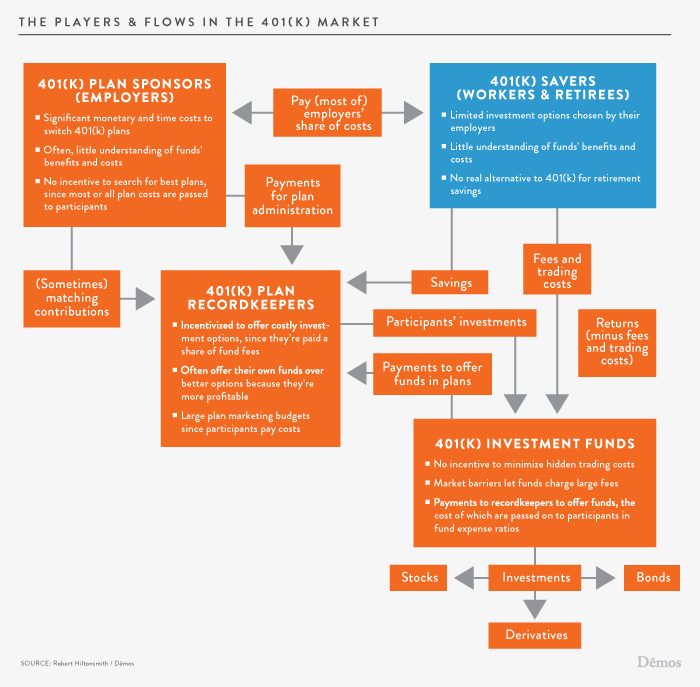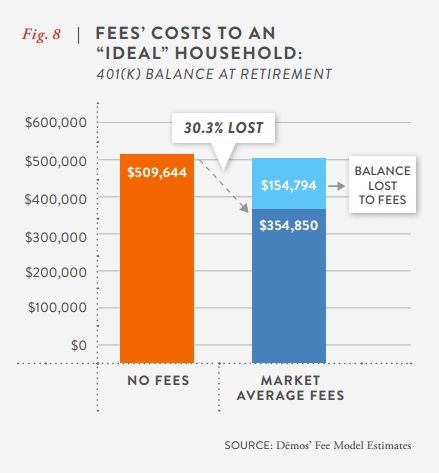The Retirement Savings Drain The Hidden Excessive Fees of 401(k)s
Post on: 2 Август, 2015 No Comment

Though your retirement or bank accounts statements contain no evidence of it, everyone who has an IRA, 401k, or any other individual retirement savings account pays a variety of fees every year. But because these fees are taken “off the top” of investment returns or share prices accountholders generally have no idea how much all of this is costing them.
These fees can be substantial: over a lifetime, fees can cost a median-income two-earner family nearly $155,000 and consume nearly one-third of their investment returns. Worse, these fees are often excessive and financial services companies can get away with charging higher-than-necessary fees for a number of reasons, namely: the savers’ lack of information, the inefficiency of financial markets and individualized investing, and the substantial costs—both in money and time—associated with switching between investment brokers.
This brief sheds light on the hidden costs of 401(k)-type individual retirement plans, details the different types of fees paid by the consumers, and uses an example investment from Demos’ own 401(k) plan to illustrate these fees’ heavy burden on the average account-holder. Using industry data on fees, the brief estimates the high costs of 401(k) fees to a model family over a lifetime of saving for retirement. The brief also explains the causes of the nearly universal excessive fees that investment firms charge to savers, and argues for a wholesale reform of this country’s broken private retirement system.
LIFETIME FEES
- According to our fee model, a two-earner household, where each partner earns the median income for their gender each year over their working lifetime, will pay an average of $154,794 in 401(k) fees and lost returns.
- A higher-income dual-earner household, one where each partner earns an income greater than three-quarters of Americans each year can expect to pay an even steeper price: (as much as) $277,969 .

OTHER FEE FACTS
- The median expense ratio of mutual funds in 401(k) plans was 1.27 percent in 2010.
- Trading costs vary from year to year, but have been estimated to average approximately 1.2 percent a year as well.
- In the long run, the average mutual fund earns a 7 percent return, before fees, matching the average return of the overall stock market. However, the post-fee returns average only 4.5 percent, meaning that, on average, fees eat up over a third of the total returns earned by mutual funds.
- Smaller 401(k) plans have higher average fees than larger ones. The median expense ratio for plans with less than 100 participants was 1.29 percent, while for plans with more than 10,000 participants, it was 0.43 percent.
TYPES OF 401(k) or IRA FEES
- Expense Ratio Fees. This ratio incorporates the administrative, investment management, and marketing fees charged to savers. Because these fees do not vary much from year to year, they are reported as a static expense ratio and listed both in a retirement plan’s summary documents and the individual prospectuses of each mutual fund in the plan.
- Trading Fees. The costs incurred by a mutual fund when buying and selling the securities (bonds, stocks, etc.) that comprise the fund’s underlying assets. Investment managers of mutual funds pay a fee each time they buy or sell one of the securities that comprise the underlying assets of the fund, and they pass these on to savers via the funds’ share prices. Trading fees vary from year to year depending on the frequency with which fund managers buy and sell the funds’ assets.














